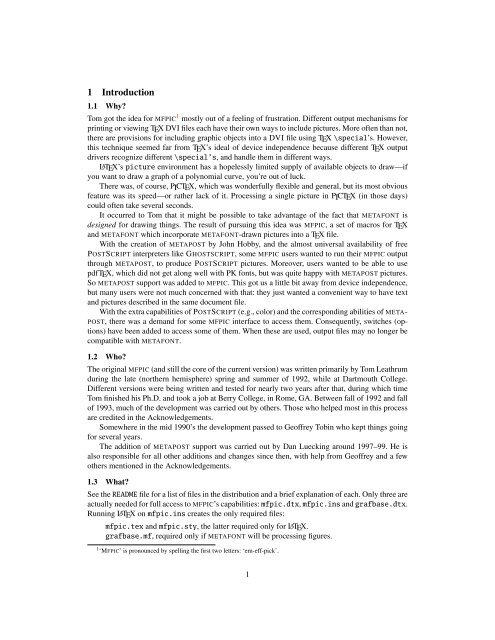You also want an ePaper? Increase the reach of your titles
YUMPU automatically turns print PDFs into web optimized ePapers that Google loves.
1 Introduction<br />
1.1 Why?<br />
Tom got the idea for MFPIC 1 mostly out of a feeling of frustration. Different output mechanisms for<br />
printing or viewing TEX DVI files each have their own ways to include pictures. More often than not,<br />
there are provisions for including graphic objects into a DVI file using TEX \special’s. However,<br />
this technique seemed far from TEX’s ideal of device independence because different TEX output<br />
drivers recognize different \special’s, and handle them in different ways.<br />
LATEX’s picture environment has a hopelessly limited supply of available objects to draw—if<br />
you want to draw a graph of a polynomial curve, you’re out of luck.<br />
There was, of course, PICTEX, which was wonderfully flexible and general, but its most obvious<br />
feature was its speed—or rather lack of it. Processing a single picture in PICTEX (in those days)<br />
could often take several seconds.<br />
It occurred to Tom that it might be possible to take advantage of the fact that METAFONT is<br />
designed for drawing things. The result of pursuing this idea was MFPIC, a set of macros for TEX<br />
and METAFONT which incorporate METAFONT-drawn pictures into a TEX file.<br />
With the creation of METAPOST by John Hobby, and the almost universal availability of free<br />
POSTSCRIPT interpreters like GHOSTSCRIPT, some MFPIC users wanted to run their MFPIC output<br />
through METAPOST, to produce POSTSCRIPT pictures. Moreover, users wanted to be able to use<br />
<strong>pdf</strong>TEX, which did not get along well with PK fonts, but was quite happy with METAPOST pictures.<br />
So METAPOST support was added to MFPIC. This got us a little bit away from device independence,<br />
but many users were not much concerned with that: they just wanted a convenient way to have text<br />
and pictures described in the same <strong>doc</strong>ument file.<br />
With the extra capabilities of POSTSCRIPT (e.g., color) and the corresponding abilities of META-<br />
POST, there was a demand for some MFPIC interface to access them. Consequently, switches (options)<br />
have been added to access some of them. When these are used, output files may no longer be<br />
compatible with METAFONT.<br />
1.2 Who?<br />
The original MFPIC (and still the core of the current version) was written primarily by Tom Leathrum<br />
during the late (northern hemisphere) spring and summer of 1992, while at Dartmouth College.<br />
Different versions were being written and tested for nearly two years after that, during which time<br />
Tom finished his Ph.D. and took a job at Berry College, in Rome, GA. Between fall of 1992 and fall<br />
of 1993, much of the development was carried out by others. Those who helped most in this process<br />
are credited in the Acknowledgements.<br />
Somewhere in the mid 1990’s the development passed to Geoffrey Tobin who kept things going<br />
for several years.<br />
The addition of METAPOST support was carried out by Dan Luecking around 1997–99. He is<br />
also responsible for all other additions and changes since then, with help from Geoffrey and a few<br />
others mentioned in the Acknowledgements.<br />
1.3 What?<br />
See the README file for a list of files in the distribution and a brief explanation of each. Only three are<br />
actually needed for full access to MFPIC’s capabilities: <strong>mfpic</strong>.dtx, <strong>mfpic</strong>.ins and grafbase.dtx.<br />
Running LATEX on <strong>mfpic</strong>.ins creates the only required files:<br />
<strong>mfpic</strong>.tex and <strong>mfpic</strong>.sty, the latter required only for LATEX.<br />
grafbase.mf, required only if METAFONT will be processing figures.<br />
1 ‘MFPIC’ is pronounced by spelling the first two letters: ‘em-eff-pick’.<br />
1

















